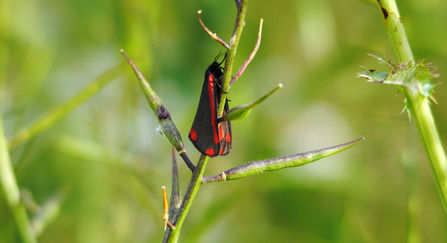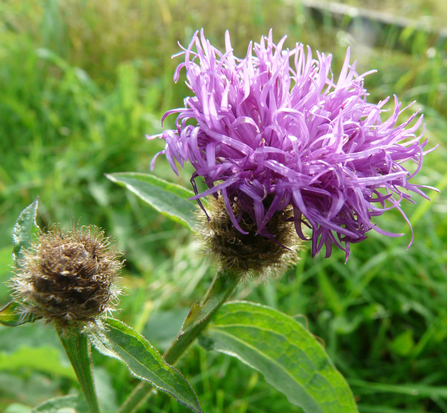August is the time to head out – when the sun does shine – to visit a meadow. By doing so, you should be rewarded with the delightful and colourful sight of wildflowers and moths! Here are a few to look out for this summer.
What to See in August
Six-spot burnet on red clover © Guy Edwardes/2020VISION

WildNet - Philip Precey
Common Ragwort is a tall plant with clusters of yellow, daisy-like flowers that attracts a huge array of insects. Although it is much maligned for its toxicity when eaten by horses and livestock, it is actually incredibly beneficial to our pollinators, including bees, butterflies and moths! In fact, over 200 species of invertebrate have been recorded on the plant. In some parts of Europe, it was believed that Ragwort could protect against lightning strikes and ward off evil. Now that’s a plant you want in your corner!

WildNet - Amy Lewis
When you find Common Ragwort, there’s also a good chance that you will find the larvae of the Cinnabar Moth. These striking caterpillars are striped with bands of orange and black, and can be found swarming the Ragwort, which is their food. This distinctive caterpillar will turn into an equally impressive moth the following year: one with scarlet hindwings and black forewings marked with a scarlet stripe and two scarlet dots. The Cinnabar Moth’s wingspan is 3.4–4.6cm and, interestingly, the moth is named after the red mineral Cinnabar, which is an ore of the metal Mercury.
© Chloé Valerie Harmsworth
Another eye-catching moth is the Six-spot Burnet Moth. This day-flying moth is patterned with six red spots on each of its long and narrow, glossy-black forewings. It is often found on purple flowers such as Knapweed, Scabious and Thistle, or flying between plants with a slow, fluttering flight pattern. The moth’s caterpillars live and feed on vetches, clovers and other low-lying plants, including Bird’s-foot Trefoil. The moth’s wingspan is 3.0–3.8cm, and its red spots indicate to predators that it is poisonous – it releases hydrogen cyanide when attacked!

CommonKnapweed © Shirley Freeman
Popular with butterflies as well as moths, Common Knapweed is a thistle-like plant with tightly-packed, pink-purple flowerheads. As with Ragwort, it can grow tall – up to 1 metre in height! This plant can be found in various environments, not just in meadows – look out for it along roadside verges, woodland rides, and popping up in lawns, too. It is in bloom from June to September, and has deeply divided, oblong leaves. Surprisingly, it is part of the daisy family, and in the 17th century, herbalists used the plant to stop bleeding and heal wounds.
For meadows and moths, great reserves to visit include Alpine Meadow on the Ashridge Estate, Aldbury Nowers in Tring, Frogmore Meadows in Chenies and King’s Meads in Ware. Find out more about our Nature Reserves here.
Here’s a Moth Spotter Guide to help you ID the moths you see, and here’s a guide of more wildflowers to look out for: Summer Flower Spotter Guide.
To get tips on taking photos of summer plants and wildlife, why not come along to our Smartphone Safari that is taking place in our wildlife garden, and around Verulamium Park, in St Albans, on Friday 9th August? Book your place here. There’s also a Summer Stroll happening at Thorley Wash on Saturday 17th August, to admire the site’s flowers and wildlife, which you can book here.

